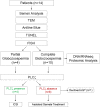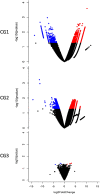Single-center thorough evaluation and targeted treatment of globozoospermic men
- PMID: 33877510
- PMCID: PMC8417186
- DOI: 10.1007/s10815-021-02191-4
Single-center thorough evaluation and targeted treatment of globozoospermic men
Abstract
Purpose: To characterize, by specific biomarkers and nucleic acid sequencing, the structural and genomic sperm characteristics of partial (PG) and complete globozoospermic (CG) men in order to identify the best reproductive treatment.
Methods: We assessed spermatozoa from 14 consenting men ultrastructurally, as well as for histone content, sperm chromatin integrity, and sperm aneuploidy. Additional genomic, transcriptomic, and proteomic evaluations were carried out to further characterize the CG cohort. The presence of oocyte-activating sperm cytosolic factor (OASCF) was measured by a phospholipase C zeta (PLCζ) immunofluorescence assay. Couples were treated in subsequent cycles either by conventional ICSI or by ICSI with assisted gamete treatment (AGT) using calcium ionophore (Ionomycin, 19657, Sigma-Aldrich, Saint Louis, MO, USA).
Results: Ultrastructural assessment confirmed complete acrosome deficiency in all spermatozoa from CG men. Histone content, sperm chromatin integrity, and sperm aneuploidy did not differ significantly between the PG (n = 4) and CG (n = 10) cohorts. PLCζ assessment indicated a positive presence of OASCF in 4 PG couples, who underwent subsequent ICSI cycles that yielded a 36.1% (43/119) fertilization with a 50% (2/4) clinical pregnancy and delivery rate. PLCζ assessment failed to detect OASCF for 8 CG patients who underwent 9 subsequent ICSI cycles with AGT, yielding a remarkable improvement of fertilization (39/97; 40.2%) (P = 0.00001). Embryo implantation (6/21; 28.6%) and clinical pregnancies (5/7; 71.4%) were also enhanced, resulting in 4 deliveries. Gene mutations (DPY19L2, SPATA16, PICK1) were identified in spermatozoa from CG patients. Additionally, CG patients unable to sustain a term pregnancy had gene mutations involved in zygote development (NLRP5) and postnatal development (BSX). CG patients who successfully sustained a pregnancy had a mutation (PIWIL1) related to sperm phenotype. PLCZ1 was both mutated and underexpressed in these CG patients, regardless of reproductive outcome.
Conclusions: Sperm bioassays and genomic studies can be used to characterize this gamete's capacity to support embryonic development and to tailor treatments maximizing reproductive outcome.
Keywords: Assisted oocyte activation; Gene mutations; Globozoospermia; ICSI; Phospholipase C zeta; Proteomics; RNA expression.
© 2021. The Author(s).
Figures


Similar articles
-
Identification and treatment of men with phospholipase Cζ-defective spermatozoa.Fertil Steril. 2020 Sep;114(3):535-544. doi: 10.1016/j.fertnstert.2020.04.044. Epub 2020 Jul 23. Fertil Steril. 2020. PMID: 32712020
-
Expression of sperm PLCζ and clinical outcomes of ICSI-AOA in men affected by globozoospermia due to DPY19L2 deletion.Reprod Biomed Online. 2018 Mar;36(3):348-355. doi: 10.1016/j.rbmo.2017.12.013. Epub 2017 Dec 29. Reprod Biomed Online. 2018. PMID: 29339016
-
Expression profile of PLCζ, PAWP, and TR-KIT in association with fertilization potential, embryo development, and pregnancy outcomes in globozoospermic candidates for intra-cytoplasmic sperm injection and artificial oocyte activation.Andrology. 2016 Sep;4(5):850-6. doi: 10.1111/andr.12179. Epub 2016 Apr 18. Andrology. 2016. PMID: 27089467
-
Total fertilization failure after ICSI: insights into pathophysiology, diagnosis, and management through artificial oocyte activation.Hum Reprod Update. 2023 Jul 5;29(4):369-394. doi: 10.1093/humupd/dmad007. Hum Reprod Update. 2023. PMID: 36977357 Review.
-
Molecular cytogenetic and genetic aspects of globozoospermia: a review.Andrologia. 2013 Feb;45(1):1-9. doi: 10.1111/j.1439-0272.2012.01308.x. Epub 2012 May 10. Andrologia. 2013. PMID: 22571172 Review.
Cited by
-
Globozoospermia: A Case Report and Systematic Review of Literature.World J Mens Health. 2023 Jan;41(1):49-80. doi: 10.5534/wjmh.220020. Epub 2022 Jul 6. World J Mens Health. 2023. PMID: 36047070 Free PMC article.
-
The intricate "ART" of ICSI.J Assist Reprod Genet. 2025 Feb;42(2):349-365. doi: 10.1007/s10815-024-03322-3. Epub 2024 Dec 23. J Assist Reprod Genet. 2025. PMID: 39714737 Free PMC article. Review.
-
Phospholipase C Zeta 1 (PLCZ1): The Function and Potential for Fertility Assessment and In Vitro Embryo Production in Cattle and Horses.Vet Sci. 2023 Dec 11;10(12):698. doi: 10.3390/vetsci10120698. Vet Sci. 2023. PMID: 38133249 Free PMC article. Review.
-
Assessing male gamete genome integrity to ameliorate poor assisted reproductive technology clinical outcome.F S Sci. 2023 Feb;4(1):2-10. doi: 10.1016/j.xfss.2022.08.001. Epub 2022 Aug 13. F S Sci. 2023. PMID: 35973556 Free PMC article.
-
Phospholipase C Zeta in Human Spermatozoa: A Systematic Review on Current Development and Clinical Application.Int J Mol Sci. 2024 Jan 22;25(2):1344. doi: 10.3390/ijms25021344. Int J Mol Sci. 2024. PMID: 38279344 Free PMC article.
References
-
- Wolff HH, Schill WB, Moritz P. Round-headed spermatozoa: a rare andrologic finding (“globe-headed spermatozoa”, “globozoospermia”) Hautarzt. 1976;27(3):111–116. - PubMed
-
- Kashir J, Sermondade N, Sifer C, Oo SL, Jones C, Mounce G, Turner K, Child T, McVeigh E, Coward K. Motile sperm organelle morphology evaluation-selected globozoospermic human sperm with an acrosomal bud exhibits novel patterns and higher levels of phospholipase C zeta. Hum Reprod. 2012;27(11):3150–3160. doi: 10.1093/humrep/des312. - DOI - PubMed
Publication types
MeSH terms
Substances
LinkOut - more resources
Full Text Sources
Other Literature Sources
Miscellaneous

